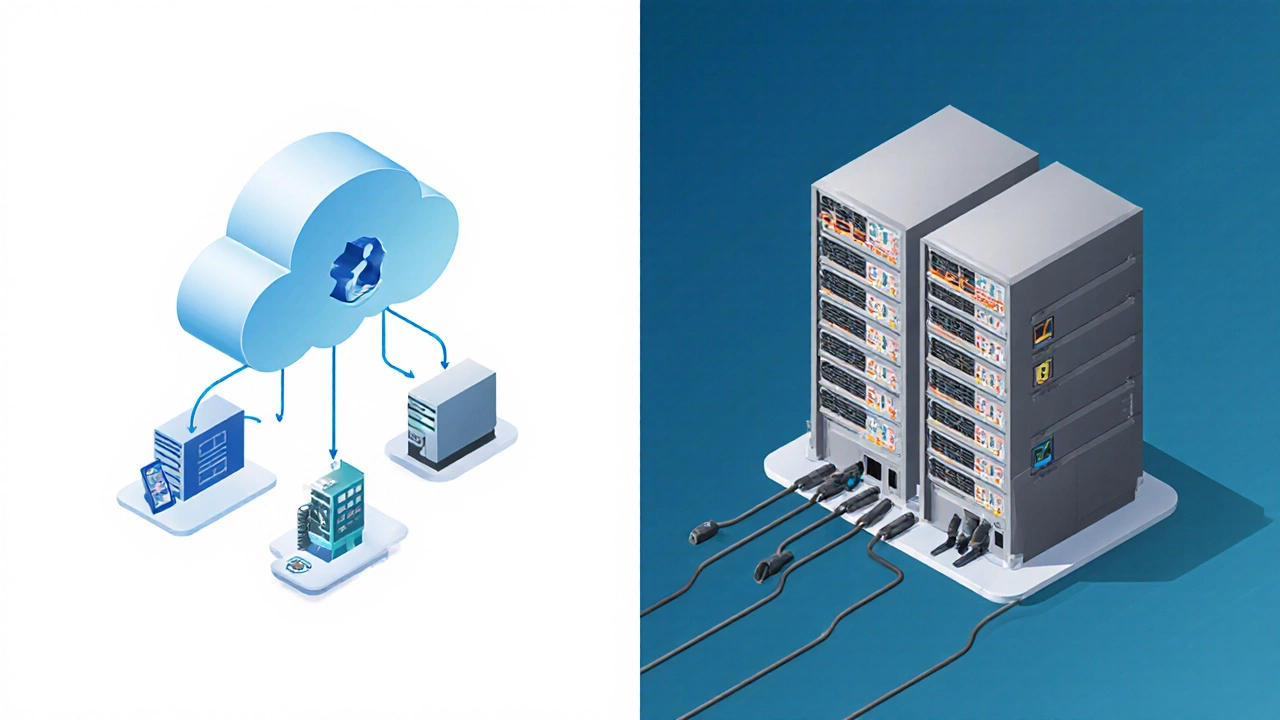WMS Deployment Cost Calculator
Deployment Comparison Calculator
Calculate your total cost of ownership over 3-5 years to compare cloud and on-premise WMS options.
Total Cost of Ownership Comparison
Cloud-Based WMS
On-Premise WMS
Cost Trend Visualization
Choosing the right warehouse management system can feel like navigating a maze of buzzwords, pricing sheets, and endless feature lists. The reality is simple: a good WMS should match the way you run your warehouse today, while giving you room to grow tomorrow. Below you’ll find a step‑by‑step plan that turns the overwhelm into a clear decision road‑map.
Key Takeaways
- Start with your business goals and warehouse processes before looking at any software.
- Prioritise integration capability - a WMS must talk to your ERP, e‑commerce platform and hardware.
- Cloud‑based solutions lower upfront costs but require reliable internet; on‑premise offers control at higher capital expense.
- Calculate total cost of ownership (TCO) over 3‑5 years, not just the licence fee.
- Use a phased implementation checklist to avoid costly disruptions.
Understand Your Warehouse Needs
Before you even open a vendor website, map out the core processes that keep your operation moving. Typical areas include receiving, put‑away, inventory tracking, order picking, packing, and shipping. Ask yourself:
- Do you handle high‑mix, low‑volume SKUs or a few high‑volume items?
- Is real‑time visibility of stock levels a must?
- How many concurrent users need system access?
- What hardware (barcode scanners, conveyor controls, sortation systems) is already in place?
Documenting these answers gives you a baseline checklist that you can later match against each system’s capabilities.
Core Evaluation Criteria
The central entity we are evaluating is a warehouse management system software that coordinates the movement, storage, and tracking of inventory within a warehouse. Use the following criteria as a scoring matrix:
- Functionality Fit: Does the system support your specific picking methods (e.g., batch, wave, zone, or pick‑to‑light)?
- Scalability: Can the platform handle a 50% increase in SKUs or order volume without performance loss?
- User Experience: Is the UI intuitive for both floor workers and managers?
- Reporting & Analytics: Does it offer real‑time dashboards, KPI tracking, and customizable reports? Reporting & Analytics features that turn raw warehouse data into actionable insights
- Support & Training: What levels of onboarding, documentation, and ongoing support are included?

Deployment Models: Cloud vs On‑Premise
Two main deployment options dominate the market today. Understanding the trade‑offs helps you align the choice with budget, IT resources, and risk tolerance.
Cloud‑based WMS software hosted on remote servers, accessed via the internet, often on a subscription basis offers low upfront costs and automatic updates. In contrast, On‑premise WMS software installed on your own servers, giving you full control over data and customisation requires a larger capital outlay but can be tuned for very specific workflows.| Aspect | Cloud‑based | On‑premise |
|---|---|---|
| Initial Cost | Subscription (monthly/annual) | License + hardware |
| Maintenance | Vendor handles updates | In‑house IT team responsible |
| Scalability | Elastic - add users/licenses instantly | Limited by server capacity |
| Data Control | Stored off‑site, subject to provider SLA | Full ownership on local servers |
| Implementation Speed | Weeks to go live | Months due to hardware setup |
Integration & Compatibility
Modern warehouses rarely operate in isolation. Your WMS must communicate with an Integration API set of protocols that allow different software systems to exchange data that links to ERP, e‑commerce platforms, and downstream transport management systems (TMS). Check these points:
- Does the vendor provide pre‑built connectors for popular ERP suites (SAP, NetSuite, Microsoft Dynamics)?
- Can the system ingest data from handheld barcode scanners and RFID readers?
- Is there support for EDI or web‑hooks to push order data to downstream carriers?
- How easy is it to build custom extensions using REST or SOAP services?
When you can see a clear integration roadmap, you reduce the risk of “siloed” data that often leads to inventory inaccuracies.
Cost, ROI, and Total Cost of Ownership
Vendors love to showcase low licence fees, but the real financial picture includes hidden costs. Build a three‑year TCO model that captures:
- Software licence or subscription fees.
- Implementation services (consultants, data migration, testing).
- Hardware upgrades (servers for on‑premise, network upgrades for cloud).
- Training for staff.
- Ongoing support and upgrade fees.
- Potential productivity gains (reduced picking errors, faster throughput).
Quantify the benefits by estimating labor savings (e.g., a 10% reduction in pick‑time translates to X fewer labor hours per year) and error‑related cost reductions. When the projected ROI exceeds the three‑year TCO, you have a solid business case to move forward.

Vendor Landscape and Shortlist
Here are five vendors that consistently rank high in 2025 reviews, each with a different sweet spot:
- Manhattan Associates - best for large enterprises needing deep optimisation and extensive carrier integrations.
- Fishbowl Inventory - strong for mid‑size manufacturers that want tight coupling with QuickBooks.
- Softeon - excels in omni‑channel fulfillment and offers both cloud and on‑premise deployments.
- SkuVault - a cloud‑first solution ideal for e‑commerce sellers looking for quick set‑up and real‑time inventory sync.
- Ceva Logistics WMS - provides a hybrid model with robust labour management features for labor‑intensive warehouses.
Use the earlier scoring matrix to rate each vendor against your must‑have criteria. The top two scores become your short‑list for demos.
Implementation Checklist
A smooth rollout hinges on planning. Follow this phased checklist to keep disruptions minimal:
- Project Kick‑off: Assign a project manager, set milestones, and define success metrics.
- Process Mapping: Document current workflows; identify gaps the WMS will fill.
- Data Clean‑up: Verify SKU master data, unit of measure, and location hierarchy.
- Configuration: Set up receiving rules, put‑away strategies, and pick methods in the system.
- Hardware Integration: Connect barcode scanners, conveyor controls, and sortation equipment via the Integration API.
- User Acceptance Testing (UAT): Run pilot picks with a small crew, gather feedback, adjust parameters.
- Go‑Live Cut‑over: Switch from legacy processes during a low‑volume window, monitor key KPIs closely.
- Post‑Go‑Live Support: Keep a dedicated support desk for the first 30 days, track issues, and fine‑tune workflows.
Cross‑functional involvement-operations, IT, finance, and front‑line staff-ensures that everyone owns the change.
Frequently Asked Questions
What size of warehouse needs a WMS?
Any operation that moves more than a few hundred SKUs per month benefits from a WMS. The system improves accuracy, reduces labor, and provides data for scaling, regardless of square footage.
Can I start with a cloud WMS and switch to on‑premise later?
Most cloud vendors offer data export tools, but moving to on‑premise often requires a new licence and migration effort. It's cheaper to decide early based on data‑security needs and IT capacity.
How long does a typical WMS implementation take?
A basic cloud rollout can be live in 6‑8 weeks, while complex on‑premise projects with custom integrations may stretch to 4‑6 months.
What are the biggest hidden costs?
Data migration, change‑management training, and integration development often take longer than planned. Budget an extra 15‑20% of the projected implementation cost for these items.
Do I need a dedicated IT team to run a cloud WMS?
No. Cloud solutions are managed by the vendor, so you only need staff for configuration, user training, and occasional troubleshooting.
Armed with this guide, you can move from vague research to a concrete decision that aligns with your operational goals, budget, and growth plans.





